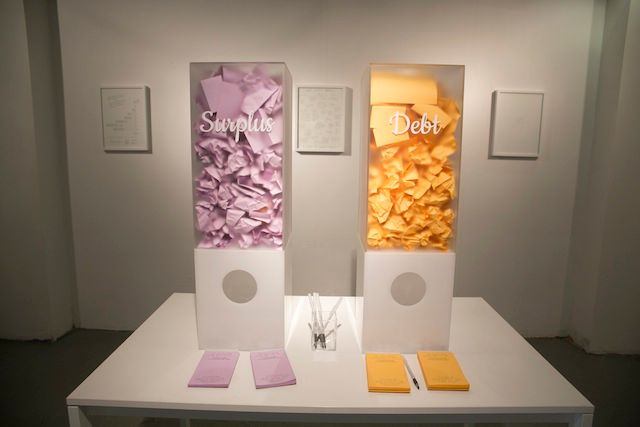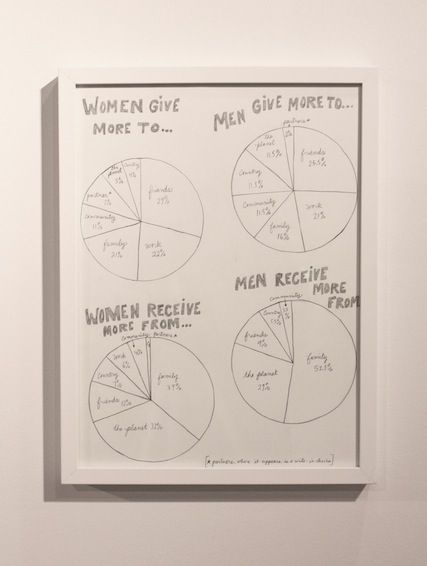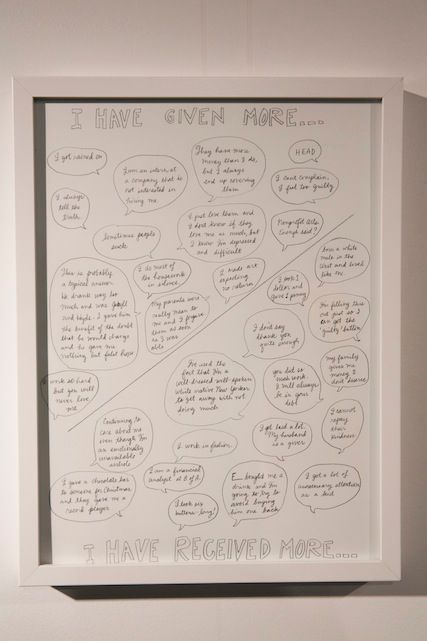NYC’s Forgotten ‘War on Christmas Trees’
Discover how an obscure holiday crackdown affects festive street vendors today!

Untapped Cities is a proud media sponsor of No Longer Empty’s latest exhibition “How Much Do I Owe You?” at the abandoned Bank of Manhattan in Long Island City. Jennifer Dalton‘s piece ‘Reckoning’ asks viewers to fill out a survey explaining whether they have given more than they’ve taken or vice versa and then take a button that labels them as a ‘giver,’ ‘taker,’ etc. Over the course of the exhibition, Jennifer has been charting the responses as drawings that are displayed on the wall behind the receptacles. We had a chance to ask her about her experience as part of No Longer Empty.

Untapped Cities: Can you tell us a little bit about the concept behind ‘Reckoning’?
Jennifer Dalton: For me, it is about how hard it is to feel comfortable with either how much you’re giving or how much you’re receiving, and it always feels fraught. It never just feel like things are working out. It feels like, I’m giving too much, I’m getting too much, and in these aspects of my life I’m so indebted and in other aspects of my life, I give and I give and I give, you know? And so I just sort of wanted to get at that, and so ‘Reckoning’ is… there is no reckoning. It’s an attempt at reckoning. It’s something we aspire to, but it never really happens, you just muddle through.
And it’s been really great as I’ve seen some of the responses. It’s really obvious that people are filling out both sides. So it isn’t like some people are givers and some people are takers. We’re all both. And at different times or in different spheres of our lives, we can feel this imbalance. And there’s no such thing as balance, I guess is what I’m trying to say.
UC: So you’ve been charting all of the responses coming in, right? Can you explain a little bit for people who haven’t seen ‘Reckoning,’ what’s on those forms?
JD: There are two—one is yellow and one is lavender. The yellow one says, “When it comes to my…” and “circle one…” and actually a lot people circle multiples “country, community, family, friends, work, planet or other, I’ve received more than I’ve given back. This is how…”
I’ve been so touched at how fully people have been filling these out and how many I’ve got. There are over 500 so far and actually I’m behind on picking them up. And people are really getting into it, spending some time with it. So people will say, “this is how…” and this person said, “When it comes to my planet, I’ve taken more than I’ve given back. This is how… air, food, life, beauty.”
I have a spot for age and then female/male, artist, middle-class, parent, liberal, conservative, working hard, financially stable, at the end of my rope. And one really interesting thing is how many people will circle both “financially stable” and “at the end of my rope.” I think “at the end of my rope” is—I didn’t realize how enticing it would be. A very large percentage of people are saying they’re at the end of their rope. Basically, I think that if you offer that as a choice, I think it almost provokes—like people maybe didn’t feel that way until they saw it and they’re like, “Yes, yes I am!” That’s just me, I’m always trying to interpret more than people have actually said. And then the purple one is exactly the same except it says, “I’ve given more than I’ve received back. This is how…”

And it’s been really interesting to plot what people say based on their reported age. So there’s a lot of children, and one of the things that’s so great about working with No Longer Empty is how many children and teenagers… They do a lot of educational work, so way more than any other show I’ve done before, there’s an audience of young people. So I’ve been plotting at different points in people’s lives if they say they give more or receive more, and the children and teenagers are very honest—I would think it’s true that in general, if you’re seven years old, you haven’t given more than you’ve been given back. And so you can see that, and when it gets to about the thirties, it evens out and it seems like the forties are the most put-upon feeling. I’m in my forties, I can attest to that. Like, with the kid and the aging parents and the career being at a middle point. In the forties, people feel like they’re giving more than they’re getting back, but it’s still very split, it’s not overwhelming, but that’s the decade where most people are saying that they’re giving more, and then it kind of gets back even with older people. We actually had a couple of people in their eighties fill it out, which is exciting.
The one that I’m working on now is… the people who said they gave more, who did they give it to? Like, what aspect of their lives. And there’s a real strong pattern here. People who said they gave more said they gave it to their friends—like they basically feel resentful of their friends—and their work and then family. And then, when you received more from the world, it’s mostly from your family. Like people who say they received more say things like, “My mom never gave up on me…” and then planet. Anyone who addressed the planet was basically saying, like, “Oh god, I’ve really taken and taken and taken and not given anything.” So there’s clear patterns with what people are more guilty about and what people are more resentful about.

UC: Have you read any really interesting responses that jumped out at you?
JD: There are some funny ones. There are some that when they say they’ve received more, they’re funny in a super blunt way. Like, one of them says, “I’m a financial analyst at B of A.” And then a lot of ones who say they’ve given more, these are people who work, they say, “Nonprofit arts. Enough said.”
“My parents were really mean to me and I forgave them as soon as I was able,” that one made me cry. And some are silly—some are like, “I got rained on.” And then a lot of them—I mean not a ton, but at least ten, have addressed the art show or my piece in particular. Like, people will say, “I take more than I give back because I only filled out one of these and I took six buttons.” Or you know Sal’s plate piece that’s a couple pieces down from mine where there’s plates on the ground and you can give money or take money back. People will say in my piece, “I gave a quarter and I took two dollars.” So there’s people being kind of funny about the show itself. And one says, “I’ve received more… born a white male in the West and lived like one.” This one’s one of my favorites. This one’s a teenager. It says, “I’ve received more… I gave a chocolate bar to someone for Christmas and I received a record player.”

UC: So it sounds like you get a pretty good range of answers, depending on the age…
JD: Yeah, and the mood. It’s a wide variety. What I’m not getting as much as I thought I might—because I open myself up for things in survey pieces like this—I often feel like I’m opening myself up for snark and for anyone to say that I suck or something obnoxious. And this is the least obnoxious set of responses that I’ve ever gotten. No one has used this opportunity to attack me or the show, maybe because the tone of the piece makes people reflect a little bit or maybe because No Longer Empty itself engenders so much good feeling.
UC: I wanted to ask you a little bit about No Longer Empty and how the experience has been…
JD: It’s wonderful. I’ve been so impressed with how organized and thoughtful it’s been. It’s been one of the better show experiences ever for me. They got us all together before the show, when everyone’s ideas were still in formation, and so to meet all the artists ahead of time and hear about all the ideas as we were all still working on them was something I’ve never done before, and that was really neat. I just feel that they really seem to have it together in a way that is really impressive, thoughtful and supportive. It’s been a really great experience.
Along with Jennifer McCoy, Jennifer Dalton recently opened Auxiliary Projects in Bushwick, a project space meant to be accessible for the middle class and artists themselves, with nothing selling for over $300. Follow her on Twitter @jen_dalton and be sure to fill out a survey at No Longer Empty’s exhibit ‘How Much Do I Owe You?’ on view until March 13.
Subscribe to our newsletter